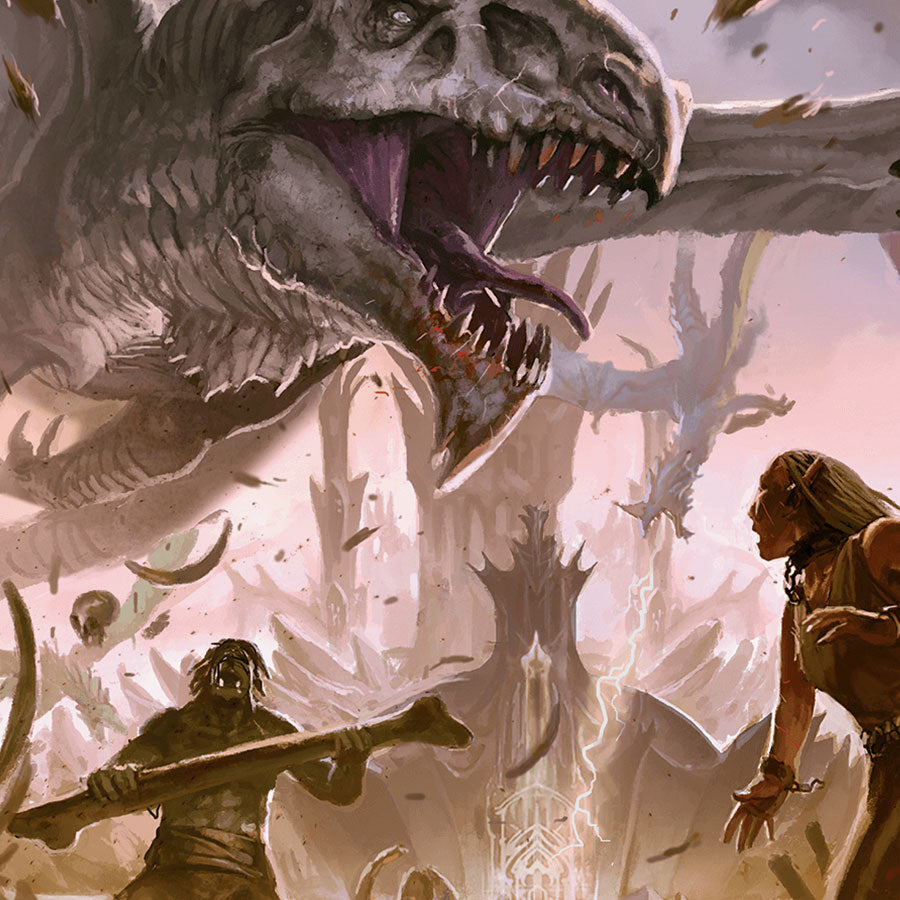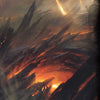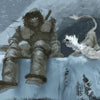How to Make a D&D Adventure in 10 Steps

Welcome, fellow Dungeon Masters, to our guide on creating immersive location-based Dungeons & Dragons adventures! Here we'll walk through the 10 crucial steps that transform a blank adventure template into a fully fleshed-out and engaging quest that your players will love.
But before we delve into the creative process, let's clarify that we're focusing on location-based adventures – a unique adventure creation approach within the vast world of D&D, which uses a specific location to design an adventure around. This differs from event-based adventures, which is a topic for another day.
Now, although these steps are in the rough order you would usually complete them, jumping around is fine, too. The order is flexible; allow your creativity to flow naturally!
By the way, if you’re a busy game master looking to reduce your prep time, we got your back. Every month my team and I publish a new issue of Lair Magazine loaded with 5e and Pathfinder 2e encounters, adventures, monsters, puzzles, traps, maps, and other resources you can use in your gams. Everything is designed to be dragged and dropped into your existing campaign, too!
Also, don’t forget to pick up our free adventure template which you can use to design any tabletop roleplaying adventure!
Watch or listen to this article by clicking the video below.
Step 1: Brainstorm Creatures and Monsters
The foundation of any great D&D adventure lies in the creatures and monsters that inhabit it. As a Dungeon Master, the initial step is to immerse yourself in the various manuals at your disposal – the Monster Manual (MM), Volo's Guide to Monsters (VGTM), and Mordenkainen's Tome of Foes (MToF). These guides provide details about monsters and their lore that can spark your imagination.
The key here is to choose monsters with Challenge Ratings (CRs) slightly lower than your party's level. Why, you ask? Well, this strategic choice allows for the creation of encounters with multiple monsters, enhancing the complexity and excitement of the battles. The boss monster’s CR, however, should match the party's level, and then the boss should be accompanied by a handful of low CR minions. This will ensure a challenging and memorable confrontation towards the end of the adventure.
Once you've selected the creatures that will populate your adventure, take the time to jot down their basic details in your template to guide you as you design your adventure.
Step 2: Jot down Game Master Notes
Every Dungeon Master knows preparation is critical to a seamless and enjoyable gaming experience. To that end, take a moment to jot down crucial Game Master (GM) notes that will guide you throughout the adventure and assist anyone else who may run it in the future.
Start by noting the party size and level for which the adventure is designed. Understanding the expected number of short and long rests is vital, aligning with the Adventuring Day mechanic described in the Dungeon Masters' Guide (DMG).
Treasure, an integral part of the D&D experience, deserves its own section in your notes. Keep track of how much loot you distribute to your players, ensuring it aligns with the DMG's recommendations.
Step 3: Create the Storyline
With creatures and notes in hand, it's time to breathe life into your adventure by crafting a compelling storyline. However, a crucial distinction must be made here – when we say "create the storyline," we're not outlining the story beat by beat. Instead, we're establishing the situation of the adventure.
Begin by focusing on three key elements:
- Set up the Villains: Identify the monsters or NPCs you've chosen as the antagonists. Consider their backgrounds and the role they will play in the unfolding drama.
- Decide What the Villains Want: Delve into the desires and aspirations of your villains. What fuels their actions? Is it power, revenge, or something more sinister?
- Decide What They're Doing to Achieve Their Goals: The conflict arises from the actions of your villains. Examples include amassing an army, conducting dark rituals, or spreading chaos.
For instance, imagine a villain named Lord Paxton who seeks to recreate the long-lost empire of Ostoria across the Sword Coast. His method involves annexing territories by force, creating conflicts and disturbances in the region.
Step 4: Flesh out Locations
Now that the groundwork is laid, it's time to breathe life into the physical spaces where your adventure will unfold. Whether it's the foreboding depths of a dungeon or the treacherous swamps teeming with monsters, each location requires attention to detail.
Begin with brief descriptions of the significant locations in your adventure. The level of detail can vary based on the significance of the location. For example, a sprawling swamp might only need high-level details, allowing you the flexibility to improvise during gameplay. In contrast, a bustling town may require more details – the names of leaders, details about the town's defenses, or even the name of a notable inn.
Remember that the level of detail you provide in these initial descriptions can be a time-saving strategy. Focus on what's essential for your players to know, and trust your ability to improvise when needed.
Step 5: Flesh out NPCs
As the architect of your adventure, it's time to populate it with characters who will guide, challenge, or hinder your players. Major Non-Player Characters (NPCs) play a pivotal role in bringing your world to life, and detailing them can significantly enhance the richness of your narrative.
Begin by compiling a list of names and brief descriptions for the major NPCs in your adventure. Keep these descriptions concise, capturing the essence of each character. Whether it's the enigmatic tavern keeper or the town's mayor, having a roster of NPCs at your fingertips allows for seamless improvisation during gameplay.
If improvisation is your strong suit, keeping NPC details short and sweet is sufficient. Remember, the goal is to strike a balance between preparation and flexibility. NPCs should enhance the narrative without overwhelming you and your players.
Step 6: Design Random Encounters
Random encounters inject spontaneity and unpredictability into your D&D adventure, offering a dynamic experience for your players. While planned encounters contribute to the narrative, random encounters are the wildcards that keep the journey exciting.
Create a set of random encounters that align thematically with the adventure and the locations where they may occur. These encounters can serve multiple purposes:
- Short Rest Encounters: If your players decide to take a short rest, introduce the possibility of a random encounter. This keeps the pace of the adventure brisk and maintains tension.
- Long Rest Mid-Adventure: Should your party attempt a long rest when they shouldn't, random encounters become an effective tool to restock the dungeon with fresh foes.
Step 7: Roll for Treasure and Loot
Treasure and loot are the tangible rewards that drive adventurers forward in their quests. Rolling for treasure adds an element of unpredictability to these rewards, ensuring that each play-through feels unique.
Utilize the Treasure Horde tables in the Dungeon Masters' Guide to determine the loot for your adventure. While this method generally works well, be mindful that, after around level 8, your party might find themselves swimming in gold. Conversely, in the early levels, they may be starved for resources.
To maintain balance, create a comprehensive list of all the treasure and loot that will be scattered throughout the adventure. As you develop the details of different locations, strategically place loot in various spots rather than concentrating it all at the end. This rewards players for thorough exploration and engagement with the entire dungeon rather than simply rushing toward the climax.
Step 8: Create the Inciting Action or Adventure Hook
Crafting a compelling, inciting action or adventure hook is crucial to capturing the attention and interest of your players.
A successful adventure hook consists of three key elements:
- Clearly Describe the Problem: Present a concise and vivid description of the problem that needs addressing. Whether it's an impending catastrophe or a brewing conflict, clarity is key.
- Provide Motivation: Give your players a reason to embark on the adventure. Motivations can range from doing the right thing, amassing wealth, seeking fame, or any combination thereof.
- Offer a Clear Next Step: Guide your players toward the adventure's location by providing a clear next step. This step should serve as a bridge between the problem and the location.
For instance, imagine the mayor of a town informing the party that a tribe of orcs has been raiding the town. He points to a map, indicating the location of the orc den. This provides a clear problem and motivation and directs the players to where the adventure will unfold.
Remember, a well-crafted adventure hook is the linchpin that transforms a passive group of adventurers into proactive heroes.
Step 9: Create Adventure Details
Now comes the exciting part of adventure creation – weaving together the intricate details that will immerse your players in the unfolding narrative. Start by focusing on two critical aspects:
Details About the Journey:
- Plan the journey to the location where the adventure takes place. This includes encounters on the road, potential obstacles, and any notable landmarks.
- These details set the tone for the adventure, building anticipation as the players traverse the world you've crafted.
- Craft an overall description of the location. Are there unique features like mystical symbols or dangerous terrain?
- Create a map for the location. Inspiration for maps can be found by exploring resources like Google and searching for "D&D dungeon maps" or similar phrases.
- Detail each room or area within the location. Use read-aloud text, bullet lists, and brief notes to convey essential information.
Building encounters within these details is essential. Balance encounters to suit your party, and include any specific notes that will aid you in running NPCs or creatures during combat.
If you find yourself grappling with ideas for the dungeon's content, consider referring to Appendix A: Random Dungeons in the DMG. This section contains tables that can serve as valuable sources of inspiration as you design your dungeon.
Remember to scatter treasure and loot throughout the adventure, rewarding players for thorough exploration and ingenuity.
Step 10: Create the Resolution
As your players navigate through the intricacies of your location-based D&D adventure, they will inevitably reach its culmination. The resolution is where the story arc finds its closure and the consequences of the players' actions come to light. To craft a satisfying resolution, focus on two key aspects:
Reward for Successful Completion:
- Define the rewards awaiting the players upon successfully completing the adventure. This could include monetary payment, increased favor with a faction, valuable items, or other incentives.
- Tailor the rewards to align with the motivations established in the adventure hook.
Consequences for Failure:
- Contemplate the potential consequences if the players fail to complete the adventure successfully. These consequences add weight to their decisions and actions, emphasizing the impact their choices can have on the game world.
- Consider the ripple effects – how does the failure affect the immediate location, neighboring regions, or even the broader campaign narrative?
By addressing these two aspects, you provide a sense of closure to your players while also laying the groundwork for future adventures.
Get that Homebrew Feel without Hours of Work!
Now, if you’re a dungeon master who loves homebrewing, you probably spend lots of time head down doing just that for your 5e or Pathfinder 2e game. However, you probably don’t have enough time to homebrew EVERYTHING for your game.
And that’s exactly how Lair Magazine can help; get that homebrew FEEL without hours of prep. You see, every issue of Lair Magazine contains a variety of 5e and PF2e resources that you can just drag and drop into your game: things like adventures, one-off encounters, monsters, traps, puzzles, and yes, even magic items.
Furthermore, my team and I design Lair Magazine content to make your game easier and faster to prep. From eloquently written read-aloud text, to area descriptions, to roleplaying and encounter notes—everything in Lair Magazine is designed to make running your 5e or Pathfinder 2 game easier!
Reduce some of the frustration and effort of being a game master. Check out all the Lair Magazine issues available here, and get more bang for your buck with the Lair Magazine bundles!
-
Posted in
Game Master How-To Articles







